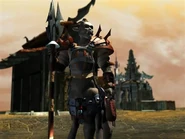Bariaurs were quadrupedal natives of the Upper Planes,[7] primarily the plane of Ysgard[1][4][2] and the House of Nature.[6]
Description
To those unacquainted, a bariaur was similar to a centaur, but while a centaur appeared to be a mixture of human and horse features, a bariaur was a mixture of human and goat features. Below the waist, they appeared like powerful rams or ewes.[3][1][4][2][7] Their torsos were similar to those of muscular humans.[3][1][4][2][7] The males[3][7] had curling horns emerging from their foreheads,[3][1][4][2] but females did not have horns.[3][7] Their skin was pale tan to dark brown in color, while the coats of their lower halves were brown or golden. Their hooves were cloven.[2]
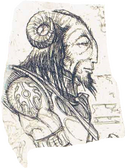
A profile image of a male bariaur.
Bariaurs typically weighed nearly 300 pounds (140 kilograms) for males and 260 pounds (120 kilograms) for females.[2] They averaged a half-foot taller than most humans.[3][2]
Most bariaurs wore some form of clothing on their upper torsos, be it a blouse, shirt, vest, or girdle. They often dyed their fur a variety of colors or shaved their pelts in stylish fashions. They wore jewelry on their horns or wove it into their hair.[7] When ready for combat, bariaurs equipped themselves with scale barding.[1][4]
Subraces
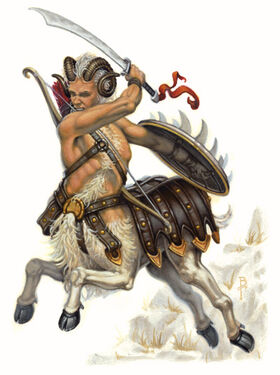
An exalted bariaur ranger.
A larger and more powerful breed of bariaur existed that were known as "exalted bariaurs". Their greater power was said to come from a closer connection to the rulers of the Upper Planes.[2] Exalted bariaurs were much bulkier, weighing upwards of 800 pounds (360 kilograms), and were numbered among the true celestials.[4]
Personality
Bariaurs tended toward a chaotic good worldview, but if not, they were almost never evil.[7] Lovers of freedom, most bariaurs were full of wanderlust,[3][1][4][2][7] but they also felt a desire to defend their home planes from evil.[1][4][2] Their carefree attitudes sometimes caused those unfamiliar with them to find them irresponsible, but this was simply an outward sign of their wanderlust.[2][7] When evil showed itself, a bariaur's carefree persona was replaced with the focused stance of a hunter.[2]
Bariaurs were social beings and very outgoing. They were slow to trust while still giving individuals the benefit of the doubt.[2][7] They got along very well with elves, gnomes, and halflings and aasimar who were not too rigid in their outlook. They would work with dwarves but were not overly fond of them. They found half-elves and half-orcs interesting and were suspicious of tieflings.[2] They had a hatred for most giants,[3][7] and on Ysgard would sometimes make an effort to destroy their lairs.[3]
Lovers of play,[3] bariaurs enjoyed competing in contests of all varieties, both mental and physical, enjoying everything from story-telling competitions to "clashes of horns" where they would charge each other in a sequence of attacks similar to a jousting match.[1][4] They threw festivals with singing contests and played a sport similar to polo.[3] They enjoyed the contests for their entertainment value and did not take most results too seriously.[3][1][4] This love of contests extended to an eagerness to "test" visitors to their realm in such games.[1][4] Bariaurs needed times of play as much as most creatures needed times of rest and would find times for games even on the most serious of epic quests of honor.[3]
Bariaur were known for great courage; they feared little—except perhaps sadness. A bariaur would do everything in his or her power to help lessen the sadness of a friend, even if it meant traveling the planes.[3]
As a rule, bariaurs paid a lot of attention to their appearance, making an effort to express their originality through their style of dress and choice of jewelry.[7]
Abilities
Bariaurs were naturally resistant to many magical spells.[3][1][4][2] They had keen senses[3][1][4][2][7] and could see in the dark.[1][4][2][7] Bariaurs were faster than humans.[3][1][4][2][7]
Males tended to be stronger and physically tougher than females, but they were less observant. Females were particularly intelligent and wise, as a rule, but were physically weaker than males. They had keener senses than males and were more resistant to magic. Neither sex were as agile as one might expect.[7]
Society
Bariaurs did not construct towns or villages—one exception being the town of Steadfast on Ysgard.[8][9]—and most did not even have houses.[7] They rarely settled in one place for a long time; instead, they roamed Ysgard, the House of Nature, or other planes in flocks of up to 80 persons,[1][4] but a typical flock contained between five and a score males and between ten to thirty females, with up to a dozen young. These flocks were extended families and did not split up under most circumstances.[3]
Flocks were led by a leader,[3][1][4] who had absolute control over the flock.[3] This single leader could be male or female[1][4] and remained in control until being ousted in a "clash of horns" competition,[3][1][4] which was a formalized event, not a chaotic one.[3] Being ousted from a position of leadership did not bring with it dishonor; the former leader simply recognized that his or her time as leader had passed.[3]
Some bariaur did not wander as a member of a herd, preferring instead to live a sedentary life—such as one of pasturing sheep—or to join an adventuring party.[7] They rarely stayed in cities for long periods of time; if found in a city, it usually meant that the bariaur was only visiting for business or adventure.[7]
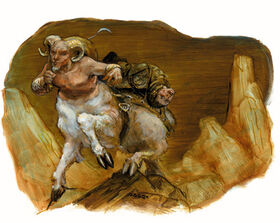
A bariaur carrying a prisoner on his back.
The bariaurs of Ysgard rarely moved to other layers of that plane unless food was scarce.[3] They traveled from great hall to great hall of the Norse gods, always ready to defend themselves from petitioners of that plane. Since petitioners here were reborn each morning, bariaurs were more likely to attack petitioners first and ask questions later.[10] If possible, they simply avoided the annoying petitioners, who were always wanting to fight and die glorious deaths. The bariaurs were difficult to track, as they were constantly moving from meadow to hill to plain to highlands.[11]
Besides Ysgard[3][1][4][2][7]—where they could freely move from layer to layer[3]—and the House of Nature,[6] smaller populations could be found in the Beastlands or on Elysium or Arborea.[7]
On the Outlands, large flocks of between ten and a hundred bariaurs roamed the area from the gate-towns of Ecstasy to Glorium. They were usually very helpful to visitors to the Outlands, offering aid or directions. The separate tribes were in close communication with each other, so a harm done to one tribe would likely be reported to another.[12]
Most bariaurs were culturally herbivores;[3][1][4] even the thought of eating meat was repulsive to most of them.[7] They knew the best sources of nuts, leaves, and berries.[3][1][4] An exception, however, were their rangers, who would eat the meat of their hunts.[1][4]
Evil bariaurs were extremely rare and were exiled from the flock.[2]
Language
Bariaurs did not have their own native tongue,[2] and instead spoke the Celestial language and Common,[1][4][2] primarily speaking the former amongst themselves.[2] They occasionally learned the fiendish languages to better prepare themselves for attacks from such creatures.[2]
Bariaurs received their names from their parents, which were usually one or two syllables for ease of shouting across the hills. Within a flock, a male would use the patronym "buck of" to refer to his father, while a female would use "doe of" to show her relationship to her mother. When outside his or her flock, a bariaur would use a flock name.[2]
Common male names included Bex, Hul, Jek, Menok, Ril, and Wyk. Common names for female bariaurs were Daeth, Hysh, Saph, Tyth, and Vash. Some typical flock names were Cloverfield, Dalewatcher, Hillwalker, and Woodstrider.[2]
Religion
Most bariaurs of Ysgard worshiped Ehlonna, the goddess of the woodlands from the world of Oerth,[1][4][2] even though her realm was in another plane.[13] Others venerated gods of strength or the sun.[2]
Combat
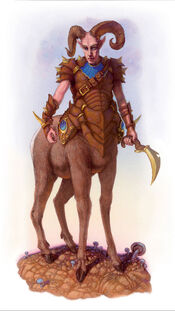
A bariaur standing his ground.
Many bariaurs became rangers.[2][7] A few were drawn to become fighters[2][7] or barbarians.[2] Males would sometimes become clerics or paladins but rarely wizards, while females, on the other hand, favored either the divine or the arcane arts.[7] Whatever their skills, bariaurs were fierce combatants.[7]
As soon as a male bariaur reached adulthood—as soon as his horns began to grow—he would never be found unarmed.[7] Bariaur passed along clubs as family heirlooms, with generations of a family's history etched in runes upon the wood. To lose such a weapon brought with it great dishonor.[3]
Male bariaurs often began a fight by lowering their heads and charging with their thick, curled horns.[1][4][7] When fighting as flocks, bariaurs employed archers to support their melee forces. Warriors often bore large clubs[3] or scimitars[1][4] and archers used composite longbows.[1][4]
Ecology
Bariaurs reached adulthood at 20 years of age and could live well past 200 years.[2][5]
History
Some sages speculated that bariaurs were created by the same sylvan deity that created centaurs. Others balked at the idea.[3]
Notable Bariaurs
- Glin, a guide for the Torilian paladin Ambran the Seeker, from the court of King Azoun Obarskyr IV.[14][15]
- Imhotep, a bariaur that served as the proxy of the deity Seker.[16]
Appendix
See Also
Gallery
Appearances
- Adventures
- For Duty & Deity
- Novels
- Finder's Bane • Tymora's Luck • The Crystal Mountain
- Video Games
- Planescape: Torment
- Card Games
- Blood Wars
- Magazines
- Dragon #204, "The Plane Truth Part II: A Journey to the Outlands" • Dragon #205, "The Plane Truth Part III: The Transformation"
References
- ↑ 1.00 1.01 1.02 1.03 1.04 1.05 1.06 1.07 1.08 1.09 1.10 1.11 1.12 1.13 1.14 1.15 1.16 1.17 1.18 1.19 1.20 1.21 1.22 1.23 1.24 1.25 1.26 1.27 1.28 1.29 1.30 1.31 1.32 1.33 1.34 1.35 Jeff Grubb, Bruce R. Cordell, David Noonan (September 2001). Manual of the Planes 3rd edition. (Wizards of the Coast), p. 161. ISBN 0-7869-1850-8.
- ↑ 2.00 2.01 2.02 2.03 2.04 2.05 2.06 2.07 2.08 2.09 2.10 2.11 2.12 2.13 2.14 2.15 2.16 2.17 2.18 2.19 2.20 2.21 2.22 2.23 2.24 2.25 2.26 2.27 2.28 2.29 2.30 2.31 2.32 2.33 2.34 2.35 2.36 2.37 2.38 2.39 Bruce R. Cordell, Gwendolyn F.M. Kestrel (July 2004). Planar Handbook. (Wizards of the Coast), pp. 7–8. ISBN 0-7869-3429-8.
- ↑ 3.00 3.01 3.02 3.03 3.04 3.05 3.06 3.07 3.08 3.09 3.10 3.11 3.12 3.13 3.14 3.15 3.16 3.17 3.18 3.19 3.20 3.21 3.22 3.23 3.24 3.25 3.26 3.27 3.28 3.29 3.30 3.31 3.32 3.33 3.34 Allen Varney, ed. (June 1994). Planescape Monstrous Compendium Appendix. (TSR, Inc.), pp. 32–33. ISBN 978-1560768623.
- ↑ 4.00 4.01 4.02 4.03 4.04 4.05 4.06 4.07 4.08 4.09 4.10 4.11 4.12 4.13 4.14 4.15 4.16 4.17 4.18 4.19 4.20 4.21 4.22 4.23 4.24 4.25 4.26 4.27 4.28 4.29 4.30 4.31 4.32 4.33 James Wyatt, Darrin Drader, Christopher Perkins (October 2003). Book of Exalted Deeds. (TSR, Inc), pp. 165–167. ISBN 0-7869-3136-1.
- ↑ 5.0 5.1 5.2 5.3 5.4 5.5 Bruce R. Cordell, Gwendolyn F.M. Kestrel (July 2004). Planar Handbook. (Wizards of the Coast), p. 18. ISBN 0-7869-3429-8.
- ↑ 6.0 6.1 6.2 Richard Baker, James Wyatt (March 2004). Player's Guide to Faerûn. (Wizards of the Coast), p. 158. ISBN 0-7869-3134-5.
- ↑ 7.00 7.01 7.02 7.03 7.04 7.05 7.06 7.07 7.08 7.09 7.10 7.11 7.12 7.13 7.14 7.15 7.16 7.17 7.18 7.19 7.20 7.21 7.22 7.23 7.24 7.25 7.26 7.27 7.28 David "Zeb" Cook (1994). Planescape Campaign Setting, A Player's Guide to the Planes. Edited by David Wise. (TSR, Inc), pp. 11–12. ISBN 978-1560768340.
- ↑ 8.0 8.1 Wolfgang Baur and Lester Smith (1994-07-01). “The Book of Chaos”. In Michele Carter ed. Planes of Chaos (TSR, Inc), pp. 122–123. ISBN 1560768746.
- ↑ Cosmographical Tables included in David "Zeb" Cook (1994). Planescape Campaign Setting. Edited by David Wise. (TSR, Inc). ISBN 978-1560768340.
- ↑ Wolfgang Baur and Lester Smith (1994-07-01). “The Travelogue”. In Michele Carter ed. Planes of Chaos (TSR, Inc), pp. 40–41. ISBN 1560768746.
- ↑ Wolfgang Baur and Lester Smith (1994-07-01). “The Book of Chaos”. In Michele Carter ed. Planes of Chaos (TSR, Inc), p. 106. ISBN 1560768746.
- ↑ Jeff Grubb (May 1995). A Player's Primer to the Outlands. Edited by Ray Vallese. (TSR, Inc.), p. 28. ISBN 0-7869-0121-7.
- ↑ Colin McComb (October 1996). On Hallowed Ground. Edited by Ray Vallese. (TSR, Inc.), p. 180. ISBN 0-7869-0430-5.
- ↑ David "Zeb" Cook (April 1994). “The Plane Truth Part II: A Journey to the Outlands”. In Kim Mohan ed. Dragon #204 (TSR, Inc.), pp. 28–30.
- ↑ David "Zeb" Cook (May 1994). “The Plane Truth Part III: The Transformation”. In Kim Mohan ed. Dragon #205 (TSR, Inc.), pp. 51–53.
- ↑ Colin McComb (October 1996). On Hallowed Ground. Edited by Ray Vallese. (TSR, Inc.), p. 90. ISBN 0-7869-0430-5.
Connections
| Angel (any good alignment) | ||
| Archon (lawful good) | Guardinal (neutral good) | Eladrin (chaotic good) |
Arcadian avenger • Asura • Bariaur • Couatl • Einheriar • Foo creature (Foo dog • Foo lion) • Harmonious choir of the words • Hollyphant • Ki-rin • Lillend • Moon dog • Pegasus • Shirokinukatsukami • Sliver • Unicorn (Celestial charger)
Related Creatures
Aasimar (Deva) • Celestial creature • Half-celestial

